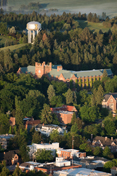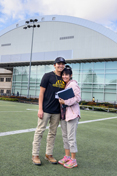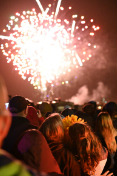Asian American Sites and Museum Exhibits in the Pacific Northwest, Great Basin and Canada
Boise - Idaho State Museum run by the Idaho State Historical Society
Exhibits of artifacts from the Ah Fong family's herbal medicine shop, Chinese temple objects, and items from local Chinese residents.
Boise - Morris Hill Cemetery
Japanese and Chinese gravestones and shrine/burner.
Burley - Bureau of Reclamation (Minidoka incarceration camp Materials)
Some planning documents and plat maps are housed here.
Cottonwood - The Historical Museum at St. Gertrude
Clothing and other objects that once belonged to Polly Bemis. Artifacts from local Chinese residents.
Eden - Minidoka incarceration camp. See Minidoka incarceration camp.
Grangeville - Bicentennial Historical Museum
Polly Bemis's wedding ring, plus artifacts from local Chinese residents.
Hope - May Den's Gravestone
Gravestone of May Den, 1890-1925, in English and Chinese, in the town cemetery, and gravestone of her husband, Louis Den.
Hunt - See Minidoka incarceration camp.
Idaho City - Boise Basin Museum
Items related to Idaho City's former Chinese residents.
Idaho City - Granite Creek Heritage Trails: Hop Lee Placer
Placer mine operated by Chinese miners during the 1860s and 1870s. Inquire locally.
Idaho City - Pon Yam House
Home of Pon Yam, a prominent Idaho City Chinese merchant and conflict mediator.
Jerome County - Idaho Farm and Ranch Museum (Minidoka incarceration camp Barracks)
One barrack building interprets the Minidoka incarceration camp experience. Located in Jerome at the crossroads of Highway 93 and Highway 84. It is some 18 miles from the Minidoka incarceration camp site.
Jerome County - Jerome County Historical Museum
In Jerome. Contains bound WWII Northside News and Minidoka Irrigator newspapers, Minidoka Interlude souvenir book, and some artifacts.
Jerome County - Minidoka War Relocation Authority Camp Site. See Minidoka incarceration camp; Minidoka National Historic Site
Lewiston - Chinese at the Confluence: Lewiston's Beuk Aie Temple
Permanent exhibit at the Lewis-Clark Center for Arts & History, Fifth and Main streets. Honors the early Chinese of Lewiston, ensuring that the achievements of "Lewiston's other pioneers" are recognized and remembered for the benefit of future generations. Illustrated booklet available.
Lewiston - Chinese Gravestones
In a section of Lewiston's Normal Hill Cemetery, near 13th Avenue and 4th Street.
Lewiston - Prospect Park
Site of turn-of-the-century Chinese cemetery, on Prospect Avenue overlooking the Snake River. Graves all relocated. Interpretive sign.
Lowell - Kooskia Internment Camp Site
The camp was located six miles above Lowell, at Canyon Creek. Today, little remains of this World War II camp (mid-1943 to mid-1945) for Japanese aliens who helped construct portions of U.S. Highway 12. The Apgar picnic area, one-half mile further east, was once the site of Kooskia Internment Camp employee housing.
McCall - McCall Ranger District Office
Exhibit of Chinese artifacts from the Warren Mining District.
Minidoka incarceration camp
Off Highway 25 and Hunt Road, near Eden. Euphemistically called a "Relocation Center," it housed more than 9,000 Japanese and Japanese Americans, most of them forcibly removed from the Seattle and Portland areas. It is not at or even near the town of Minidoka. Portions of a stone guard house and a stone visitors' waiting room remain; several plaques have been installed in more recent years. The Friends of Minidoka have another Web site. To visit a barracks building, see Jerome County - Idaho Farm and Ranch Museum.
Minidoka National Historic Site
See directions at Minidoka incarceration camp.
Minidoka Relocation Center. See Minidoka incarceration camp; Minidoka National Historic Site
Minidoka War Relocation Authority Camp Site. See Minidoka incarceration camp; Minidoka National Historic Site
Moscow - Asian American Comparative Collection
Housed in the Laboratory of Anthropology at the University of Idaho. Chinese, Japanese, and Korean artifacts; bibliographical materials; and slides.
Orofino - Clearwater Historical Museum
Contains some history of the Chinese in the Pierce and Oro Fino areas. The earlier Oro Fino is not the same place as the modern Orofino.
Pierce - Chinese Cemetery
Depressions indicate where former burials were exhumed. Contact city for more information.
Pierce - Pierce Free Public Library
Exhibit of Chinese artifacts.
Polly Bemis Ranch. See Salmon River - Polly Bemis's Cabin and Grave
Potlatch - Japanese Gravestone
The city cemetery has a gravestone, dated August 30, 1917 (5th year of Taisho period) marking the burial location of a former resident of Japanese ancestry.
Salmon - Lemhi County Historical Museum
Exhibits include artifacts from Salmon's former Chinese residents, plus a "Chinese Room" of objects (clothing, tablewares, pipes, swords, knives, and tapestries) collected in China and elsewhere in Asia during the 1920s by a couple from nearby Leesburg.
Salmon River - Remains of Chinese Mining
Hydraulic workings, man-made reservoirs, rock dwellings, and Chinese artifacts attest to the presence of Chinese miners on the Lower Salmon River.
Salmon River - Polly Bemis's Cabin and Grave
Idaho Chinese pioneer Polly Bemis lived in this cabin on the Main Salmon River from 1922 to 1933. She is buried nearby. Easily accessible only by jet boat from Riggins. Slide lecture available.
Silver City - Chinese Settlement
Chinese artifacts are visible on the ground in Silver City's former "Chinatown."
Twin Falls - Twin Falls Public Library
Research materials on the Minidoka incarceration camp, including newspaper articles, a diary, a thesis on the camp, and Journey to Minidoka paintings by Roger Shimomura, c. 1983.
Warren - Chinese Cemetery
Depressions indicate where former burials were exhumed.
Warren - Chinese Gardens and Old China Trail
Upper terraced gardens; trail leads down to others near the South Fork of the Salmon River. Information available from Payette National Forest, McCall, and from Warren Ranger Station.
Warren - Warren Ranger Station
Outdoor display panels discuss local Chinese history.
Warren - Winter Inn (scroll down)
Local tavern has display cases containing labeled Chinese artifacts.
Butte - Archaeological Excavations
"Digging Butte's Chinatown" is a photo diary of the excavation and shows some of the recovered artifacts.
Butte - Mai Wah Society
Building that once housed the Wah Chong Tai Co. store and the Mai Wah Noodle Parlor. Exhibits during the summer months.
Butte - World Museum of Mining
Outdoors; buildings depict a Chinese apothecary shop and a Chinese laundry (displays inside; look through the windows).
Helena - Montana Historical Society
Houses major items from Butte's Mai Wah Noodle Parlor. The Paul Eno collection includes clothing, household goos, photographs, and phonograph records.
Louisville - Mineral County Historical Society and Museum
Photo plus brief discussion of excavations at this site.
Nevada City - Replicated Chinatown
Contains a store and several other buildings, complete with contents, from Chinese businesses in other communities.
Douglas County - Allan Taylor Cabin
A historical cabin, likely constructed by one of Nevada's Chinese wood cutters in the late nineteenth century (exact location not disclosed).
Douglas County - Glenbrook Cabins
Cabin and adjoining structures built by Chinese laborers in the nineteenth century as part of logging operations (exact location not disclosed).
Gold Creek - Island Mountain
This placer mining community began about 1873, and was 76% Chinese by 1880.
Incline Village - Incline Village
Historical site of Chinese labor camp and lumber operations.
Nye County - Carson & Colorado Railroad Company Culverts
Railroad culverts constructed by Chinese laborers in the late nineteenth century (exact location not disclosed).
Nye County - High Desert Chinese Campsite
Remains of a Chinese labor camp; occupied while constructing and maintaining the nearby Carson & Colorado railroad, road, and drainage systems (exact location not disclosed).
Nye County - Mt. Montgomery Tunnel
This 247-foot tunnel through Mt. Montgomery was created by Chinese laborers between 1880 and 1883 (exact location not disclosed).
Sparks - Sparks Museum and Cultural Center
Includes a preserved railroad bridge built by Chinese immigrants and a memorial to Chinese railroad workers.
Winnemucca - Humboldt County Museum
Houses artifacts and information about the Chinese in the Winnemucca area. Has a Chinese altar on display.
Astoria - Columbia River Maritime Museum
Exhibits illustrate maritime ties with Asia, and Asian cannery workers.
Astoria - Garden of Surging Waves
Chinese garden commemorating the contributions of Chinese immigrants to Astoria. Website also has links to Astoria Chinese history and videos.
Baker City - Chinese Cemetery
Contains depressions where previous burials were exhumed, and one marker for a burial that still remains. Cemetery probably contains other, unmarked, burials. Reconstructed shrine/burner. See location information.
Baker City - Mt. Hope Cemetery
Contains about 15 gravestones, some in Japanese, of Japanese nationals and Japanese Americans who died in Baker City during the 1920s and 1930s. Also several gravestones indicating burial locations of deceased Chinese American residents.
Baker City - National Historic Oregon Trail Interpretive Center
Chinese names appear on a page reproduced from the 1870 Baker City census; several Chinese artifacts.
Baker City - Baker Heritage Museum
Artifacts from local Chinese residents.
Bend - High Desert Museum
One exhibit recreates a Chinese store.
Brogan - Harada Japanese Garden
This garden commemorates Japanese American farmers in Brogan.
Canyon City - Chinatown of Canyon City
Once the home of 162 recorded Chinese residents, no structures associated with Canyon City's Chinatown remain but the Grant County Historical Museum and the murals at the Canyon City park commemorate its history.
Field - Borax Lake
Former site of a refining plant that employed Chinese laborers to collect and process sodium borate from sediments around Borax Lake.
Granite - Ah Hee Diggings
Sixteen [not sixty, as often misheard and perpetuated] acres of hand-stacked rock tailings left by Chinese placer miners. Also known locally as the "Chinese Walls." Illustrated site report and slide lecture available. Additional information.
Grant County - Happy Camp Mining District
Over 1200 acres of archaeological features like ditches, dams, reservoirs, tailings piles, and cabin sites that are predominantly the remnants of nineteenth century Chinese placer mining (exact location not disclosed).
Hells Canyon - Chinese Massacre Cove
In 1887, Euroamerican thugs massacred some 34 Chinese miners at Deep Creek on the Oregon side of the Snake River. Accessible only by jet boat or a difficult 8.6 mile hike from the Dug Bar boat launch. Location information.
Huntington - Clark's Cafe Sign
Sign painted on brick wall of building for long-gone business; sign states, "All White Help," meaning, no Chinese. Note that this building burned down in 2019.
John Day - Kam Wah Chung State Heritage Site
Former Chinese store and herbal medicine shop housing a vast array of Chinese artifacts.Websites about this heritage site are maintained by Oregon State Parks and by the Friends of Kam Wah Chung. See additional information about the John Day Chinatown that once surrounded this building.
Lake Oswego - Oswego Iron Works
Remains of the Oregon Iron Company, which employed Chinese laborers, can be found in Lake Oswego's George Rogers Park. The park site includes the former location of the Chinese workers' housing and is the entrance point to the Oswego Iron Heritage Trail.
Medford vicinity/Applegate Valley - Gin Lin Mining Trail
Remains of Chinese hydraulic mining near Applegate Lake within the Rogue River National Forest.
Multiple - Chinese Place Names
A blog with a list of over 300 places in Oregon with names reflecting Chinese heritage.
Ontario - Four Rivers Cultural Center and Museum
Includes exhibits on local Japanese Americans as well as on the World War II incarceration of Japanese Americans, such as a recreated incarceration camp barrack. It also has a Japanese garden.
Pendleton - Chinese Graves and Burner, Olney Cemetery
The Chinese section, on the southwest side, has some 23 gravestones and a brick burner.
Pendleton - Pendleton Underground
An interesting tour of downtown Pendleton basements. However, some guides call them "Chinese tunnels" thus perpetuating a stereotype for which there is no basis in fact. See "Ongoing Research" for a discussion of so-called "Chinese tunnels."
Portland - Japanese American Historical Plaza
Thirteen inscribed stones honor the legacy of Portland's Japanese American residents before, after, and during World War II.
Portland - Japanese Garden
Multiple garden spaces, a Cultural Village, Japanese Arts Learning Center, and galleries with rotating exhibits on Japanese art, design, and culture.
Portland - Lan Su Chinese Garden
Chinese garden with a tea house and a rotating schedule of events and exhibits.
Portland - Oregon Nikkei Legacy Center
A museum and cultural center honoring Japanese Americans in Oregon.
Portland - Portland Chinatown Museum
Museum with permanent and rotating exhibits about Portland's Chinese population and Chinatowns.
Prairie City - Ah Heng Placer Mine
A multi-feature gold mining complex that was leased by the Ah Heng Company in the late nineteenth century. The Malheur National Forest offers a virtual tour and a GeoCache has also been established at the site.
Prairie City - Ah Yee Placer Mine
Five placer mining feature complexes extending over 150 acres that were owned by Ah Yee and Company in the late nineteenth century. This site can also be explored through the mobile app Agents of Discovery.
Union Creek - Chinese Mining Site
Three-tiered, rock-walled, water delivery channel, originally fed by two earthen dams.
Unity - Eldorado Ditch
An interpretive sign in Unity, Oregon, and a mural in Vale, Oregon, both commemorate the extensive Eldorado Ditch (also known as the El Dorado or the Big Ditch) network constructed by Chinese laborers in the late nineteenth century to supply water for mining operations in the vicinity.
Box Elder County- Transcontinental Railroad Backcountry Byway Driving Tour
An 87-mile section of abandoned railroad grade that was built by Chinese workers in 1869, now marked with interpretive signs.
Delta - Great Basin Museum
Numerous artifacts from the Topaz incarceration camp.
Delta - Topaz Internment Camp
140 miles southwest of Salt Lake City. Today the site contains roads, rock walls, manholes, concrete slabs, rubble, and miscellaneous artifacts.
Ogden - Union Station Museum
Exhibit on Chinese and Japanese railroad workers located inside the historic Union Station Depot.
Promontory Summit - Golden Spike National Historical Park
U.S. National Park commemorating the completion of the transcontinental railroad. Includes an exhibit on Chinese railroad workers, "Chinese Arch," and a plaque dedicated to the Chinese railroad workers who lost their lives.
Between Kamas and Hanna - Masashi Goto Monument
Monument along road to Japanese American pilot Masashi Goto, who died while attempting a transglobal flight in 1929. An image of his memorial can also be seen here.
Auburn - White River Valley Museum
Exhibit of Japanese farmhouse, c. 1915.
Bainbridge Island Historical Museum
The Bainbridge Island Historical Museum includes an exhibit on the history and archaeology of two Japanese immigrant communities centered around the Port Blakely mill.
Long Beach - World Kite Museum & Hall of Fame
Our of 1400 kites, the museum has 700 kites from Japan, China, and Malaysia. The collection of 300 Japanese kites is considered the most complete outside of Japan. There are also some Indonesian kites. Displays rotate.
Port Townsend - Antique Mall
Basement reportedly has a display of Chinese artifacts relating to 1880s Chinese residents.
Port Townsend - Diamond Point Quarantine Station
Many Asian immigrants were detained in this facility, or passed through it, between 1893 and 1935. It is now mostly demolished.
Port Townsend - Jefferson County Historical Society
The Chinese in Port Townsend; artifacts of the Zee Tai Company, a Chinese mercantile establishment, as well as historic photos and a discussion of the opium trade.
Seattle Chinatown Historic District. See Seattle - International District
Seattle - Chinese Garden
Admission is free, and your dog is welcome!
Seattle - International District
Historically, the home of Chinese, Japanese, and Filipino immigrants. Places of particular interest include the Bing Kung Association, the Bush Hotel, Canton Alley, the Chinese Bulletin Board, Chinese Cultural Service Center, Chinese Information & Service Center, Chong Wa Benevolent Association, Danny Woo International District Community Garden, Hing Hay Park, Jackson Street Colonnade, Panama Hotel, Tai Tung Restaurant, Tsue Chong Noodle Company, and the Yick Fung Company.
Seattle - Kubota Garden
Japanese immigrant Fujitaro Kubota created this 20-acre garden in 1927. Located at 9817 55th Ave. South, the garden "blends Japanese and Japanese American garden concepts with native Northwest plants" (David Takami, International Examiner, 31[9]:14, May 5-18, 2004).
Seattle - Wing Luke Museum of the Asian Pacific American Experience ("The Wing")
Contemporary and historical exhibits of Asian and Pacific Islander groups.
Stevenson - Columbia Gorge Interpretive Center
Exhibit of Japanese household objects.
Tacoma - Reconciliation Park
Site of Chinese commemorative park near early Chinese settlement burned in 1885 during anti-Chinese riot.
Vashon Island - Mukai Farm and Garden
Owned by Denichiro Mukai, and later by his son, Masa, this was once the largest strawberry farm in the U.S. Denichiro's second wife, Kuni, created the Japanese garden. It is the only one surviving that is known to have been designed by a Japanese immigrant woman.
Walla Walla - Chinese Gravestones and Shrine/Burner
In the city cemetery; scroll to end of link.
Barkerville, British Columbia - Barkerville Historic Town
Several of the restored and recreated Chinese buildings in Barkerville's oldest Chinatown include the Yan War Store, the Chee Kung Tong Hall, and the Lung Duck Tong restaurant.
D'Arcy Island, British Columbia - Leper Colony
"The island was used as a leper colony for Chinese immigrants from 1894 to 1924, and ruins of the buildings built during that time are still visible."
Fort Steele, British Columbia - 1890s Town with a Chinatown
Fort Steele once had a substantial Chinatown, including a Chinese doctor/herbalist. Wild Horse Creek, nearby, also had a Chinese population.
Lytton Chinese History Museum, British Columbia - Chinese Canadian History and Artifacts
Museum housing over 1,300 artifacts and documents related to the historical contributions of Chinese Canadians. View digital collections.
Nikkei National Museum & Cultural Centre - Japanese Canadian History and Heritage
Museum with both permanent and rotating exhibits on Japanese Canadian History. The cultural centre also hosts educational and cultural events.
O'Keefe Ranch, British Columbia - Chinese Cooks/Gardeners
Archaeological work in 1992 recovered a few Chinese artifacts related to the site's former Chinese cooks/gardeners.
Salt Spring Island, British Columbia - Cusheon Cove
The Bulman-Alison Lumber Company, established in 1905, employed Chinese and Japanese laborers at their mill. Artifacts from both groups have been found there.
Vancouver, British Columbia - Wing Sang Company building and Yip family artifacts in Vancouver Museum
The Yip Sang Building is at 51 East Pender Street. Over 300 related artifacts are housed in the Vancouver Museum.
See Links for additional information.






